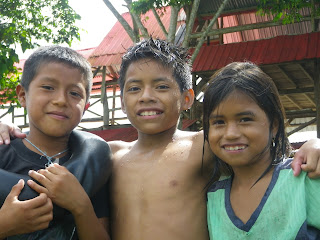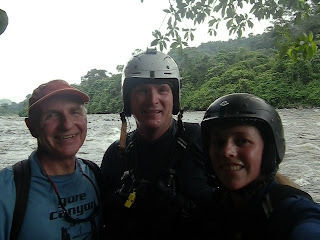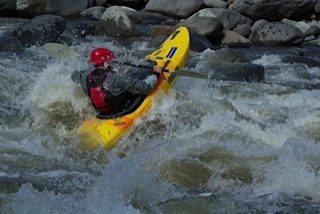Edging in Ecuador
Mike styling this boof slot on the Upper Tena. After 3 days of big water paddling, Mike was stoked to get on some technical runs. It made him feel much more at home!
Learning to kayak in Ecuador!
Many people have the misconception that Ecuador is for advanced kayakers only.
It’s true that Ecuador has an amazingly high number of world Class IV-V runs packed into a tiny area; but what people often overlook are equally incredible Class II and III runs that the country also has to offer.
The group enjoying some sunshine and awesome jungle scenery on the Upper Misahualli
For the December 10th week we had a group of 5 aspiring kayakers come to Ecuador to hone their Class II skills and break into the Class III realm of kayaking.
We worked on a wide variety of skills this week but Tarquino and I both decided that learning how to edge successfully and practicing this skill in a variety of river situations is probably the most important skill to for an up an coming Class III boater to work on (that and combat rolling of course! For more on the combat roll, check out our Nov. 26th blog http://smallworldadventures.blogspot.com/2011/12/ever-important-but-often-elusive-combat.html)
Some very impressive fungus growing on an old log along the banks of the Rio Tena. The jungle is an amazing place that never ceases to amaze me
Why is edging important? Well, you need to have good control of your edges for pretty much everything you do in kayaking—peeling into and out of eddies, surfing waves, moving your boat from point a to point b in any given rapid, boofing and much more.
In the Class II/III stage of kayaking, gaining control over your edge is quite a difficult thing to do, but with practice, the skill will start to feel more and more natural until, eventually, you won’t even realize you are doing it anymore.
Linda learning how to surf on the "perfect practice waves" on the Middle Misahualli while Tarquino coaches from the eddy
First let’s start with the definition of edging…it’s pretty simple, it just means getting your boat on edge and maintaining this edge. Once you are on edge, you release 20-80% (depending upon just how much you get on edge!) of the hull’s surface area connection with the water, therefore making a myriad of kayaking moves easier.
To achieve an edge, start by weighting 1 butt cheek, pulling up on the opposite knee and more or less doing a sideways sit up--AKA the side crunch. Most new kayakers won’t have the strength for good edging, so it’s important to do these practice skills to build up those obliques to allow you edge better and more effectively in the river—edging will give you those abs you’ve always wanted! Actually doing side crunches at home will help you build the necessary muscles for edging in the river so as soon as you are finished reading this blog, hit the floor mat and do some sit ups!
John acts as life guard while some kids who were on a field trip from school try their hand at kayaking
To get the hang of edging, you need to start simply—just practice edging in the eddies. Edge to your left. Now hold it and see if you can balance. Take you paddle out of the water and find your balance point, try to hold it for 5 seconds. Now to the other side because you want to be comfortable on both edges!
Happy kids after having hijacked the kayaks! These kids were awesome--what, paddle around the Project 45 with 2 of my bigger friends sitting on it? No problem!
Practice holding the edge for 5 seconds to start, then build up to 10 and even 20 seconds. Once you can comfortably do this in the eddy and it’s not causing the “ab burn” so much anymore, put it into practice in moving water.
Apply that same edge as you peel out of the eddy into the current.
Kathy practicing her paddle stroke timing through one of Ecuador's many awesome wave trains
Find an easy Class II rapid and practice shifting from edge to edge as you go down the rapid. In this same easy rapid, start on the left side of the rapid and make a move to the right side. For this move, you’ll want to get on your left edge, take a sweep stroke on the left to turn your kayak towards the right (where you want to go) and now take some forward strokes while maintaining that left edge until you reach your destination on river right. Find a technical river with TONS of eddies. Peel into and out of every eddy you possibly can over exaggerating your edge transfer. This will help you build the strength, the balance, the muscle memory and the technique required for good edging.
John navigating the Misahualli's boulder garden rapids
Once you gain control over your edges and get good at “edging” you’ll find that you flip over less frequently and it’s all of a sudden so much easier to make those hard right to left cuts in the middle of a rapid. It will be easier to catch eddies and peel out of eddies and you’ll find you can eventually start using little eddies behind rocks in technical runs to make your moves. It will be easier to brace, and if it’s not clear by now, EVERYTHING about kayaking will be easier!
So get out there and work those edges!
PARTING SHOT
Life ain't so bad so remember to enjoy it!














































